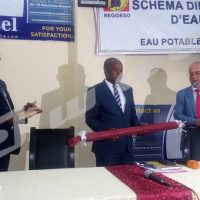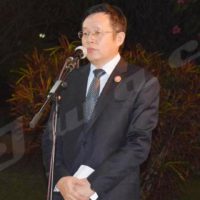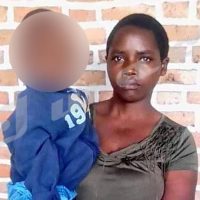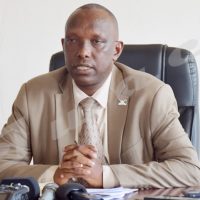After three days of investigations on the ground, Iwacu journalists found a body in the area where, according to several sources, the journalist disappeared. Iwacu decided to publish the following account of the investigations.
Friday, August 5

“Bihongo”: The ravine in which was thrown the corpse discovered by Iwacu journalists.
Shortly after the disappearance of Jean Bigirimana, Iwacu started an investigation to find the journalist. All the information we possessed, as did the CNIDH, indicated that our colleague was abducted in Bugarama in the afternoon of Friday July 22.
On Friday August 5, at 2 pm, a reliable source told us that there was a corpse in the Mubarazi River in the rural district of Muramvya province.
2:30 pm: “Finding Jean” is set up
An emergency meeting was held via whatsapp between Antoine Kaburahe, the Iwacu Director and Léandre Sikuyavuga, the Chief Editor along with other journalists. Very quickly, a team of Iwacu experienced reporters and a photographer was selected for the mission. Abbas Mbazumutima, deputy chief editor and a veteran of the profession, was appointed a team leader.
To facilitate communication, especially with Antoine Kaburahe in Brussels, a whatsapp group named “Finding John” was created.
The team took some fees from the financial manager; they checked cameras, bought phone credits and took some notebooks and then started off. It was 2:40 pm exactly 40 minutes after Iwacu received the information about the corpse.
3 pm on the National Road (RN1)
Journalists, in a deafening silence, drove along RN1, commonly known as Bugarama Road. They were aware of the seriousness of the situation. Besides, the imminent danger of the dusk worried everyone. They urged the driver to accelerate. He replied with a joke: “You always say that a good journalist is a journalist who is alive, so a good driver is a driver who is careful.” After that short break, the team lapsed into silence again. The driver concentrated on the road. The whole team was nervous, emotional and anguished.
First field investigation, first failure
Not to endanger the sources, Iwacu will not say how and who told reporters the place. (…). For more than two hours, the journalists went up and down the hills to reach the “scene”.
They searched along the Mubarazi River according to directions given by informants. But they found nothing. Around 6 pm, the team met people going home from their farms.
They were a little afraid, they couldn’t talk. “A dead body? I have never heard of that before! Shootings? Not in the recent days! Besides, I am not from here. Ask someone else”, said one female farmer. When asked, most people turned away and smiled in a manner that communicated more: “The Burundian way”.
Journalists were convinced that even if people didn’t want to talk, they knew something. Discreetly, one person said: “between Burambana, Nyabisiga and Ruyenzi hills”. Meanwhile, it was almost 6:30pm. The field of investigation was too broad, but the journalists were determined to continue”.
Antoine Kaburahe advised “Finding Jean” to cancel the mission
At 6:30 pm, Antoine Kaburahe sent a message from Belgium to “Finding Jean”: “Stop the mission”. A hot exchange with Abbas began. Despite the team’s will to carry on, Antoine definitely took the decision: “Stop and go back to Bujumbura. It’s an order now”. Finally, the team obeyed. Later on, Kaburahe justified his decision: “They were in a hostile environment, by a river at 6:30 pm. They didn’t have flashlights; they could fall in a ravine. I am a journalist. I understand the passion of these journalists, their desire to find out the truth, the fate of our colleague. But I’m also the director of Iwacu. In some way, they are under my charge. Friday at 6:30 pm, I took the responsibility to suspend the mission. It was only later in the debriefing session that the journalists recognized that the director was right to suspend the investigation.
The decision was made to resume the investigation the next day, Saturday, August 6. Absolute discretion was required of everyone.
Saturday August 6, a surprise awaited Iwacu

Iwacu journalists during their inquiries on the scene.
Saturday at 6 am, the team, more determined than ever, started out. When they arrived at the scene they were surprised to find there the Muramvya higher police officer with two other police officers, probably his transmission agents. “Finding Jean” realised they were no longer alone. Obviously, the information about the journalists’ presence on Friday leaked. A team of the National Independent Commission on Human Rights (CNIDH) arrived in a large gleaming 4×4 vehicle. The chairman of the Commission took time to encourage his team before continuing his way. That was not all. The Public Prosecutor in Muramvya was there with an officer who seemed to be of the criminal investigation police. And above all, an ambulance with a medical doctor joined the group. And finally, a pickup of the National Intelligence Service with tinted windows arrived with four people. Two were police officers.
Kaburahe and Mbazumutima the leader of the “Finding Jean” team started an uneasy conversation on whatsapp. The director told the team to stop the mission and leave the place.
Later, the Director explained: “I couldn’t believe that Iwacu, the police, the intelligence service and the CNIDH could lead an investigation together. Something was wrong. It was no more an investigation but a mere exchange. And I was sure nothing good could result from it. But the team leader and the other reporters on the spot could not abide by the director’s instruction and remained with those officials. Abbas Mbazumutima explained afterwards: “officially, all those people were there to help us. Deciding to leave and not conduct inquiries together might have been misconstrued and be used against us. I asked Kaburahe to allow for a minimum of trust and I decided to continue with my colleagues. I knew he would understand.”
Combined “Research” of Iwacu, National Intelligence Services-SNR and the National Commission for the Human Rights-CNIDH
“So, let us go to get this lifeless body floating on the Mubarazi River”, said a CNIDH commissioner. He took the lead and everyone followed him, but before going down to the river, a lady of the CNIDH realized that her high-heeled shoes might delay the team. She decided to wait for their return.
The slope was steep and rocky, there was not even a track, and the young police officers went on scouting. The team rushed down the hill by rolling stones, some stumbled, even fell; we clung to the few trees found on our passage.
Having arrived at the foot of the hill, the heterogeneous team took a breath, but the ordeal was not over. You had to jump to get to the other side of a stream flowing into the Mubarazi River. The young police officers led the others and crossed the river the first.
“Not everybody could engage in such exercises,” said the prosecutor.
He decided to take off his shoes and cross it on foot. The team started along the Mubarazi River through the fields of vegetables and potatoes. The whole team started to scrutinize any clues, any suspicious items. We stopped, we observed and even asked some shepherds, but got nothing. The team turned back empty-handed.
Back on the tarmac road the members of the team were all exhausted.
“We have done what we could”, seem to say these people. We in fact noted some contentment. They said goodbye. It was the beginning of the weekend. Except that the IWACU team was not convinced at all. But it didn’t let show anything.
In the car that was bringing reporters to Bujumbura, a message of Antoine Kaburahe , presenting apologies fell. But the team reassured him that they understood his reserves and it was only a postponement. The journalists decided to return to the field on Sunday. They hoped that that time they would really be alone on the ground. They just wanted to come back alone, discreetly.
Sunday, on 7 August, back to the scene
Friday and Saturday, the journalists were able to gather some information. “Most of the inhabitants of the Gatamera hill knew that there is a body, spending several days in the Mubarazi River near the Bihongo waterfall. They knew it, but kept silent for fear of prosecution, “said a young shepherd.
“There are even some who speak of eleven bodies packed in bags that were carried away by the Mubarazi River. Even this body wedged between rocks was upstream of the river before being carried up to a few meters from the haunted waterfall”, said another young man who came to gather firewood on the side of the Gatamera hill.
He admitted that he saw the body and heard, a few days ago, gunshots in the night. “Even in Nyabisiga locality, some residents said they heard weapons crackling. And as usual, they remain silent to avoid endangering their lives”, he indicated without giving more details of these ‘indiscretions” which could be expensive.
A resident of the Gatamera hill tried to link the gunshots heard and the discovery of the body in the Mubarazi River with the kidnapping of the journalist Jean Bigirimana. “Those who witnessed his abduction and saw how he was embarked with brutality in the back of a “pickup” vehicle with tinted windows concluded that he would not get away alive.”
Sunday, the journalists decided to go through other paths, not by Ruyenzi, but by Nyabisiga, as they did on Friday and Saturday. They wanted to see “the waterfalls with a corpse blocked by rocks.” A piece of information reported by a source on Saturday, August 6th
Sunday, on the 7th of August, with a very discreet guide, we went to these places, the waterfalls of Bihongo where “the dead body carted away by the river was seen.” From Nyabisiga, reporters went to Gatamera hill through eucalyptus plantations. “The hill is steep; the descent to the Mubarazi river is difficult,” warns



















 IWACU Open Data
IWACU Open Data

